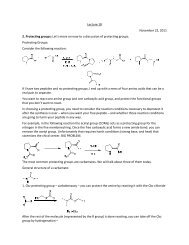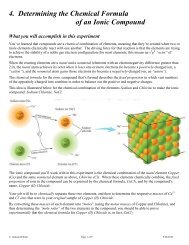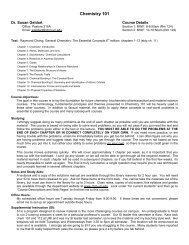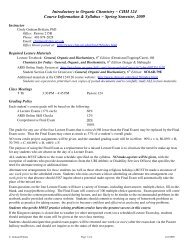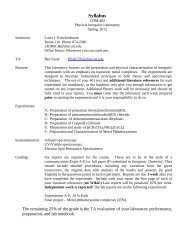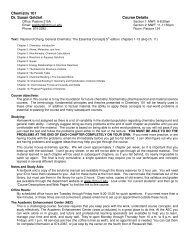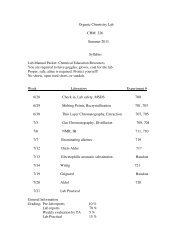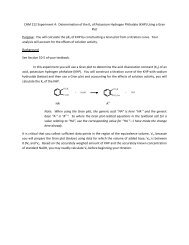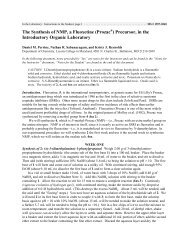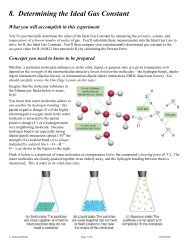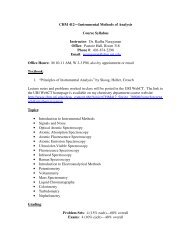One-Pot Synthesis of Squaraine Fluoroionophores - American ...
One-Pot Synthesis of Squaraine Fluoroionophores - American ...
One-Pot Synthesis of Squaraine Fluoroionophores - American ...
Create successful ePaper yourself
Turn your PDF publications into a flip-book with our unique Google optimized e-Paper software.
J. Org. Chem. 1998, 63, 6059-6060<br />
6059<br />
<strong>One</strong>-<strong>Pot</strong> <strong>Synthesis</strong> <strong>of</strong> <strong>Squaraine</strong><br />
<strong>Fluoroionophores</strong><br />
Scheme 1<br />
Umut Oguz and Engin U. Akkaya*<br />
Department <strong>of</strong> Chemistry, Middle East Technical University,<br />
TR-06531 Ankara, Turkey<br />
Received March 18, 1998<br />
<strong>Squaraine</strong>s are 1,3-disubstituted squaric acid derivatives<br />
with sharp visible absorption peaks in solution and<br />
panchromatic absorption in the solid state. This class<br />
<strong>of</strong> fluorescent dyes and pigments is well-known for their<br />
applications in electrophotography, 1 organic solar cells, 2<br />
nonlinear optics, 3 and optical data storage. 4 Their photochemistry<br />
has been extensively studied, 5 and many<br />
derivatives <strong>of</strong> the parent squaraine skeleton have been<br />
synthesized mostly for improvements in technical applications.<br />
In recent years, squaraines also received<br />
attention as fluorescent labels. 6 Their very promising<br />
spectral properties such as long wavelength absorption<br />
and emission, high extinction coefficients, and quantum<br />
yields make them particularly attractive in this area. In<br />
addition, the rational design <strong>of</strong> fluorescent chemosensors 7<br />
is a vibrant field <strong>of</strong> organic chemistry, and appropriately<br />
derivatized squaraines could lead to novel sensing technologies<br />
as they can be excited with solid-state lasers.<br />
There are already successful examples <strong>of</strong> squarainebased<br />
chemosensors in the literature, 8 and such modified<br />
squaraines were shown to signal pH, alkaline, and earthalkaline<br />
metals in various solvent systems. When the<br />
range <strong>of</strong> selectivities that could be achieved by the<br />
judicious choice <strong>of</strong> the crown ethers is considered, azacrown-appended<br />
squaraines (squaraine fluoroionophores)<br />
are targets <strong>of</strong> prime importance.<br />
The general synthetic methodology used in the preparation<br />
<strong>of</strong> squaraines is rather simple. 9 It involves a<br />
reaction <strong>of</strong> 2 equiv <strong>of</strong> dialkylanilines with 1 equiv <strong>of</strong><br />
squaraic acid, preferably in n-BuOH/toluene (50:50) at<br />
reflux temperatures. Water formed could be either<br />
(1) Law, K.-Y. Chem. Rev. 1993, 93, 449, and references therein.<br />
(2) Loutfy, R. O.; Hsiao, C. K.; Kazmaier, P. M. J. Photogr. Sci. 1983,<br />
27, 5.<br />
(3) (a) Chen, C.-T.; Marder, S. R.; Cheng, L. T. J. Chem. Soc. Chem.<br />
Commun. 1994, 259. (b) Andrews, J. H.; Khagdarov, J. D. V.; Singer,<br />
K. D.; Hull, D. L.; Chuang, K. C. Nonlinear Opt. 1995, 10, 227. (c)<br />
Ashwell, G. J.; Jefferies, G.; Hamilton, D. G.; Lynch, D. E.; Roberts,<br />
M. P. S.; Bahra, G. S.; Brown, C. R. Nature 1995, 375, 385.<br />
(4) Emmelius, M.; Pawlowski, G.; Vollmann, H. W. Angew. Chem.,<br />
Int. Ed. Engl. 1989, 28, 1445.<br />
(5) Law, K.-Y. J. Phys. Chem. 1987, 91, 5184.<br />
(6) (a) Ghazarossian, V.; Pease, J. S.; Ru, M. W. L.; Laney, M.;<br />
Tarnowski, T. L. Eur. Pat. Appl. EP 356173 A2, 1990. (b) Terpetschnig,<br />
E.; Szmacinski, H.; Ozinskas, A.; Lakowicz, J. R. Anal. Biochem. 1994,<br />
217, 197.<br />
(7) Recent reviews <strong>of</strong> the field: (a) DeSilva, A. P.; Gunaratne, H. Q.<br />
N.; Gunnlaugsson, T.; Huxley, A. J. M.; Mccoy, C. P.; Rademacher, J.<br />
T.; Rice, T. E. Chem. Rev. 1997, 97, 1515. (b) Desvergne, J.-P., Czarnik,<br />
A. W., Eds. Chemosensors <strong>of</strong> Ion and Molecule Recognition; Proceedings<br />
<strong>of</strong> the NATO ASI Series C; Kluwer Academic Press: Dordrecht, The<br />
Netherlands, 1997; Vol. 492.<br />
(8) (a) Oguz, U.; Akkaya, E. U. Tetrahedron Lett. 1997, 38, 4509.<br />
(b) Akkaya, E. U.; Turkyilmaz, S. Tetrahedron Lett. 1997, 38, 4513.<br />
(c) Isgor, Y. G.; Akkaya, E. U. Tetrahedron Lett. 1997, 38, 7417. (d)<br />
Das, S.; Thomas, K. G.; Thomas, K. J.; Kamat, P. V.; George, M. V. J.<br />
Phys. Chem. 1994, 98, 9291. (e) Thomas, K. G.; Thomas, K. J.; Das,<br />
S.; George, M. V. Chem. Commun. 1997, 597.<br />
(9) Ziegenbein, W.; Sprenger, H. E. Angew. Chem., Int. Ed. Engl.<br />
1966, 5, 893.<br />
removed azeotropically or taken up by molecular sieves.<br />
The synthetic challenge in the preparation <strong>of</strong> azacrownsquaraines<br />
is essentially the preparation <strong>of</strong> phenyl- or<br />
((di)hydroxyphenyl)azacrowns, as the rest <strong>of</strong> the synthesis<br />
is straightforward. Phenylazacrowns were synthesized<br />
in 1985 by Gokel, 10 and the synthesis involves a<br />
multistep synthesis with at least one high-dilution step.<br />
No literature reports <strong>of</strong> 3-hydroxy- or (3,5-dihydroxyphenyl)azacrowns<br />
were encountered, and that is unfortunate<br />
because such hydroxy substitutions would not only<br />
increase the yield 5 in squaraine synthesis but also result<br />
in higher-quantum yield squaraines with improved solubility<br />
characteristics. 5 We report here the use <strong>of</strong> a novel<br />
one-pot reaction that provides an entry to such derivatized<br />
squaraines using simple commercially available<br />
synthons.<br />
<strong>Synthesis</strong><br />
Our synthesis makes use <strong>of</strong> the general reactivity <strong>of</strong><br />
phloroglucinol (1,3,5-trihydroxybenzene) with secondary<br />
amines through its keto tautomer. The fact that this<br />
reaction could be made to proceed in the same azeotropic<br />
solvent mixture as that <strong>of</strong> squaraine synthesis proved to<br />
be very convenient, and our azacrown-appended squaraine<br />
synthesis became a one-pot reaction. Thus, the azacrown<br />
was reacted with equimolar phloroglucinol in n-BuOH/<br />
toluene (50:50) in a Dean-Stark apparatus, where water<br />
that formed was removed continuously. (3,5-Dihydoxyphenyl)azacrown<br />
formation was complete in 6-8 h<br />
depending on the type <strong>of</strong> azacrown used. The N-phenylazacrown<br />
derivative was not isolated; instead, 0.5 equiv<br />
<strong>of</strong> squaric acid was added, and heating was continued.<br />
Typically in 15 min, the characteristic intense green color<br />
<strong>of</strong> the squaraines was observed. The reflux was continued<br />
for 4 h. On cooling, the squaraine-azacrown conjugates<br />
crystallized out <strong>of</strong> the solution. The precipitate<br />
was washed with MeOH and dried. Recrystallization<br />
was not necessary as evidenced from the analytical data.<br />
The new compounds were fully characterized by 1 H and<br />
(10) Schultz, R. A.; White, B. D.; Dishong, D. M.; Arnold, K. A.;<br />
Gokel, G. W. J. Am. Chem. Soc. 1985, 107, 6659.<br />
S0022-3263(98)00514-3 CCC: $15.00 © 1998 <strong>American</strong> Chemical Society<br />
Published on Web 08/01/1998
6060 J. Org. Chem., Vol. 63, No. 17, 1998 Notes<br />
13<br />
C NMR, mass spectrometry, and elemental analysis.<br />
NMR spectra reveal the highly symmetrical nature <strong>of</strong> the<br />
squaraines and the presence <strong>of</strong> strong internal hydrogen<br />
bonding between the ArOH and the squaryl oxygens.<br />
Experimental Section<br />
General. All reagents were purchased from commercial<br />
suppliers and used without further purification. 1<br />
H NMR and<br />
13<br />
C NMR spectra were recorded in CDCl 3 solution with TMS as<br />
an internal reference at 400 MHz ( 1 H) and 100 MHz ( 13 C). Mass<br />
spectra were recorded by electron impact (70 eV). Melting points<br />
reported are uncorrected. Elemental analyses were performed<br />
by TUBITAK Instrumental Analysis Laboratory (Ankara, Turkey).<br />
Bis[4-N-(1-aza-4,7,10,13-tetraoxacyclopentadecyl)-3,5-dihydroxyphenyl]squaraine<br />
(n ) 0). 1-Aza-15-crown-5 (0.438<br />
g, 2 mmol) and phloroglucinol (0.252 g, 2 mmol) were heated to<br />
reflux in a solvent mixture containing toluene (10 mL) and<br />
n-butanol (10 mL), accompanied by azeotropic distillation <strong>of</strong><br />
water, overnight. Without any isolation attempt, the resulting<br />
(3,5-dihydroxyphenyl)azacrown was reacted in the same solvent<br />
system with 3,4-dihydroxy-3-cyclobutene-1,2-dione (squaric acid,<br />
0.114 g, 1 mmol) by refluxing for 6hinthesame Dean-Stark<br />
apparatus. The reaction mixture was cooled to room temperature.<br />
The precipitated product was collected by filtration and<br />
washed with cold methanol (100 mL). The resulting dark green<br />
solid was dried in vacuo. The yield was 1.0248 g (70%): mp<br />
>250 °C; 1 H NMR (CDCl 3, 400 MHz) δ 3.82-3.65 (m, 40 H),<br />
5.84 (s, 4 H), 10.99 (s, 4 H); 13 C NMR (CDCl 3, 50 MHz) δ 53.62,<br />
68.59, 70.08, 70.49, 71.26, 94.11, 103.0, 158.00, 162.00, 163.03,<br />
181.00; MS (EI) m/e 730 [(M - 2H) + ], 367 [(azacrown-Ar-CHd<br />
CdO) + ]. Anal. Calcd for C 36H 48N 2O 14: C, 9.01; H, 5.56; N, 3.83.<br />
Found: C, 59.17; H, 5.66; N, 3.85.<br />
Bis[4-N-(1-aza-4,7,10,13,16-pentaoxacyclooctadecyl)-3,5-<br />
dihydroxyphenyl]squaraine (n ) 1). The same procedure<br />
applied 1-aza-18-crown-6 yielded dark green crystals with a<br />
metallic luster. The product was collected by filtration washed<br />
with cold methanol (100 mL) and 2-propanol (50 mL), and dried<br />
in vacuo. The yield was 1.23 g (75%): mp >250 °C; 1 H NMR<br />
(CDCl 3, 400 MHz) δ 3.48-3.73 (m, 48 H), 5.86 (s, 4 H), 10.84 (s,<br />
4 H); 13 C NMR (CDCl 3, 50 MHz) δ 57.12, 73.88, 75.69, 75.85,<br />
75.96, 99.13, 107.82, 163.87, 166.05, 167.70, 186.63 (one <strong>of</strong> the<br />
peaks obscured by CDCl 3); MS (EI) m/e 818 [(M - 2H) + ], 411<br />
[(azacrown-ArCHdCdO) + ]. Anal. Calcd for C 40H 56N 2O 16‚0.25<br />
H 2O: C, 58.21; H, 6.89; N, 3.39. Found: C, 57.86; H, 6.50; N,<br />
3.47.<br />
Acknowledgment. We gratefully acknowledge support<br />
from TWAS (RGA no. 96-140 RG/CHE/AS).<br />
JO9805145




